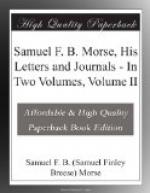The next drawing of a magnet lifting sixty pounds shows that Morse was familiar with the discoveries of Arago, Davy, and Sturgeon in electro-magnetism, but what application of them was to be made is not explained.
The last sketch is to me the most important of all, for it embodies the principle of the receiving magnet which is universally used at the present day. The weak permanent magnet has been replaced by a spring, but the electro-magnet still attracts the lever and produces the dots and dashes of the alphabet; and this, simple as it seems to us “once found,” was original with Morse, was absolutely different from any other form of telegraph devised by others, and, improved and elaborated by him through years of struggle, is now recognized throughout the world as the Telegraph.
It was not yet in a shape to prove to a skeptical world its practical utility; much had still to be done to bring it to perfection; new discoveries had still to be made by Morse and by others which were essential to its success; the skill, the means, and the faith of others had to be enlisted in its behalf, but the actual invention was there and Morse was the inventor.
How simple it all seems to us now, and yet its very simplicity is its sublimest feature, for it was this which compelled the admiration of scientists and practical men of affairs alike, and which gradually forced into desuetude all other systems of telegraphy until to-day the Morse telegraph still stands unrivalled.
That many other minds had been occupied with the same problem was a fact unknown to the inventor at the time, although a few years later he was rudely awakened. A fugitive note, written many years later, in his handwriting, although speaking of himself in the third person, bears witness to this. It is entitled “Good thought":—




